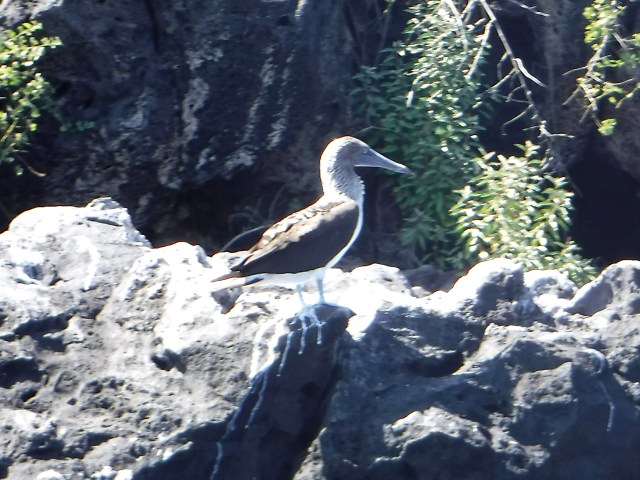Go ahead, get it out of your system – all those double entendres, jokes etc. This post is about the extraordinary species of birds found on the Galapagos Islands. I will not only pay homage to this beautiful creature, but also will try to refute the image portrayed by their name.
I don’t have an issue with its Latin genus, which is “Sula,” meaning those seabirds that plunge-dive for prey. I do take exception to its colloquial appellation: “booby.” The word is derived from the Spanish term “bobo” and it means, “fool, dope, stupid, clown.” Why did the Spanish use this term to describe the seabirds they discovered? I will explain in a moment.
First let’s take a closer look at the booby. It is a large sea bird who fishes in the waters around the Galapagos by taking spectacular vertical dives into the sea from far up above:
There are three different types of Galapagos booby: Nazca, red foot and the well-known blue-footed booby. The Nazca booby is the largest of the three, with a white head and body and mask-like black feathers around its eyes. There are over 25,000 Nazca boobies in the Galapagos – but we were only able to see a few while kayaking around the islands. Unfortunately I could not take my wonderful Canon camera during these excursions as we were in the middle of the Pacific Ocean where a rogue wave could capsize us. Instead I used my less exact waterproof camera which produced decent “air-pics:”
The red footed booby is the smallest and most rare of the booby species and most of them reside on Genovese Island, which we did not get a chance to visit. I would have liked to have seen this bird in person as it rivals the more well know blue footed booby with its striking blue beak, bright red feet and variably colored body. Here are two pics from the internet:
The red footed booby also differs from its relatives in raising a family as it only lays one egg at a time. This is quite fortuitous for the chick, as you will see.
But the most well-known and frankly my favorite is this guy:
Now about this bird’s name. The Spanish thought this bird was a “bobo” for two main reasons. 1) The boobies often landed on the Spanish ships – no doubt looking for a meal and were easily caught since they didn’t fly away at the sight of a human and 2) The boobies’ landings from the sky were considered clumsy.
I object.
While you can make the argument that the boobies perhaps look a bit clownish and perhaps should have been afraid of humans, as our species are so well-known for causing many animals to become extinct, they were simply following their basic instinct and are certainly not stupid. Besides being graceful and brilliant fisherman boobies are actually quite complicated. Take this scenario: A male booby, in order to attract a female will stamp and raise his pretty blue feet hoping the brightly hued peds will dazzle. The brighter the blue the greater the potential for finding a mate.
Once a female is interested the two begin a courtship dance of outstretched wings, beaks pointing to the sky and whistling, with the female mimicking the male. Some members of my group caught a glimpse of this ritual but didn’t get it on tape – so again from the internet:
You might think that this romantic bonding makes a monogamous pairing – au contraire. Females are known to get a little side action when the hubby is off fishing. Even when caught red-handed (or should I say blue-footed) once the indiscretion is over, the pair perform an encore of the mating dance and settle down to nesting. But aberrant behavior doesn’t end here.
Their young can be quite merciless.
Nazca and blue-footed booby chicks practice facultative siblicide, which is the fancy way of saying they ruthlessly kill their younger sibling. These two species of booby, unlike the red-footed variety, lay two eggs – a number of days apart. If there is a food shortage, the first hatched chick will either peck his younger and weaker sibling to death, or even drag it out of the nest. They can also just “hog” feeding times, making sure they get all the sustenance, while the second hatched chick slowly starves to death.
Given the above proclivities, I don’t think it is a wise decision to call these birds stupid or clownish – they obviously have a dark side.
#










